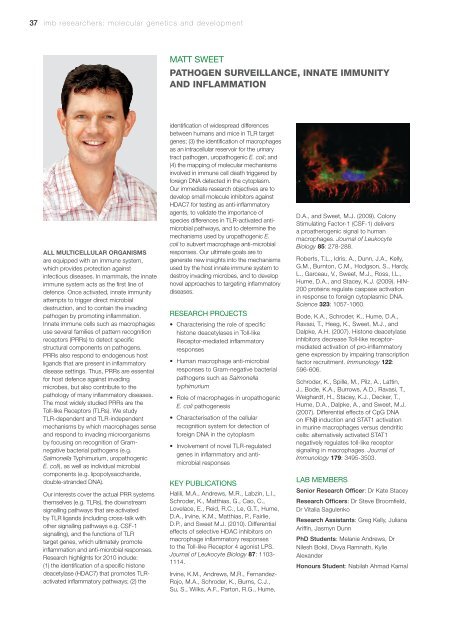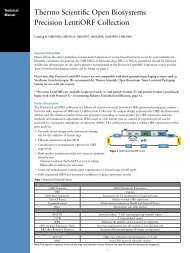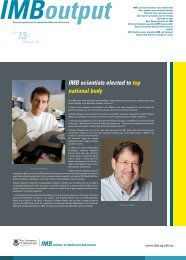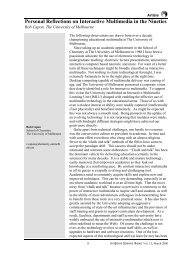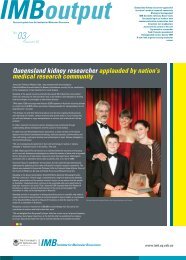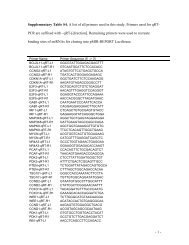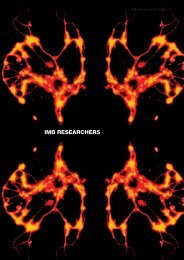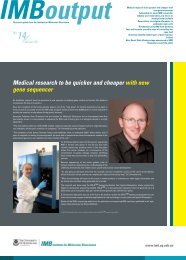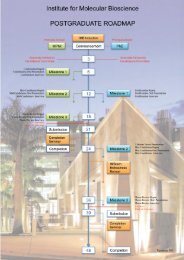2010 Annual Report - Institute for Molecular Bioscience - University ...
2010 Annual Report - Institute for Molecular Bioscience - University ...
2010 Annual Report - Institute for Molecular Bioscience - University ...
You also want an ePaper? Increase the reach of your titles
YUMPU automatically turns print PDFs into web optimized ePapers that Google loves.
37 imb researchers: molecular genetics and development<br />
MATT SWEET<br />
PATHOGEN SURVEILLANCE, INNATE IMMUNITY<br />
AND INFLAMMATION<br />
ALL MULTICELLULAR ORGANISMS<br />
are equipped with an immune system,<br />
which provides protection against<br />
infectious diseases. In mammals, the innate<br />
immune system acts as the first line of<br />
defence. Once activated, innate immunity<br />
attempts to trigger direct microbial<br />
destruction, and to contain the invading<br />
pathogen by promoting inflammation.<br />
Innate immune cells such as macrophages<br />
use several families of pattern recognition<br />
receptors (PRRs) to detect specific<br />
structural components on pathogens.<br />
PRRs also respond to endogenous host<br />
ligands that are present in inflammatory<br />
disease settings. Thus, PRRs are essential<br />
<strong>for</strong> host defence against invading<br />
microbes, but also contribute to the<br />
pathology of many inflammatory diseases.<br />
The most widely studied PRRs are the<br />
Toll-like Receptors (TLRs). We study<br />
TLR-dependent and TLR-independent<br />
mechanisms by which macrophages sense<br />
and respond to invading microorganisms<br />
by focusing on recognition of Gramnegative<br />
bacterial pathogens (e.g.<br />
Salmonella Typhimurium, uropathogenic<br />
E. coli), as well as individual microbial<br />
components (e.g. lipopolysaccharide,<br />
double-stranded DNA).<br />
Our interests cover the actual PRR systems<br />
themselves (e.g. TLRs), the downstream<br />
signalling pathways that are activated<br />
by TLR ligands (including cross-talk with<br />
other signalling pathways e.g. CSF-1<br />
signalling), and the functions of TLR<br />
target genes, which ultimately promote<br />
inflammation and anti-microbial responses.<br />
Research highlights <strong>for</strong> <strong>2010</strong> include:<br />
(1) the identification of a specific histone<br />
deacetylase (HDAC7) that promotes TLRactivated<br />
inflammatory pathways; (2) the<br />
identification of widespread differences<br />
between humans and mice in TLR target<br />
genes; (3) the identification of macrophages<br />
as an intracellular reservoir <strong>for</strong> the urinary<br />
tract pathogen, uropathogenic E. coli; and<br />
(4) the mapping of molecular mechanisms<br />
involved in immune cell death triggered by<br />
<strong>for</strong>eign DNA detected in the cytoplasm.<br />
Our immediate research objectives are to<br />
develop small molecule inhibitors against<br />
HDAC7 <strong>for</strong> testing as anti-inflammatory<br />
agents, to validate the importance of<br />
species differences in TLR-activated antimicrobial<br />
pathways, and to determine the<br />
mechanisms used by uropathogenic E.<br />
coli to subvert macrophage anti-microbial<br />
responses. Our ultimate goals are to<br />
generate new insights into the mechanisms<br />
used by the host innate immune system to<br />
destroy invading microbes, and to develop<br />
novel approaches to targeting inflammatory<br />
diseases.<br />
RESEARCH PROJECTS<br />
• Characterising the role of specific<br />
histone deacetylases in Toll-like<br />
Receptor-mediated inflammatory<br />
responses<br />
• Human macrophage anti-microbial<br />
responses to Gram-negative bacterial<br />
pathogens such as Salmonella<br />
typhimurium<br />
• Role of macrophages in uropathogenic<br />
E. coli pathogenesis<br />
• Characterisation of the cellular<br />
recognition system <strong>for</strong> detection of<br />
<strong>for</strong>eign DNA in the cytoplasm<br />
• Involvement of novel TLR-regulated<br />
genes in inflammatory and antimicrobial<br />
responses<br />
KEY PUBLICATIONS<br />
Halili, M.A., Andrews, M.R., Labzin, L.I.,<br />
Schroder, K., Matthias, G., Cao, C.,<br />
Lovelace, E., Reid, R.C., Le, G.T., Hume,<br />
D.A., Irvine, K.M., Matthias, P., Fairlie,<br />
D.P., and Sweet M.J. (<strong>2010</strong>). Differential<br />
effects of selective HDAC inhibitors on<br />
macrophage inflammatory responses<br />
to the Toll-like Receptor 4 agonist LPS.<br />
Journal of Leukocyte Biology 87: 1103-<br />
1114.<br />
Irvine, K.M., Andrews, M.R., Fernandez-<br />
Rojo, M.A., Schroder, K., Burns, C.J.,<br />
Su, S., Wilks, A.F., Parton, R.G., Hume,<br />
D.A., and Sweet, M.J. (2009). Colony<br />
Stimulating Factor-1 (CSF-1) delivers<br />
a proatherogenic signal to human<br />
macrophages. Journal of Leukocyte<br />
Biology 85: 278-288.<br />
Roberts, T.L., Idris, A., Dunn, J.A., Kelly,<br />
G.M., Burnton, C.M., Hodgson, S., Hardy,<br />
L., Garceau, V., Sweet, M.J., Ross, I.L.,<br />
Hume, D.A., and Stacey, K.J. (2009). HIN-<br />
200 proteins regulate caspase activation<br />
in response to <strong>for</strong>eign cytoplasmic DNA.<br />
Science 323: 1057-1060.<br />
Bode, K.A., Schroder, K., Hume, D.A.,<br />
Ravasi, T., Heeg, K., Sweet, M.J., and<br />
Dalpke, A.H. (2007). Histone deacetylase<br />
inhibitors decrease Toll-like receptormediated<br />
activation of pro-inflammatory<br />
gene expression by impairing transcription<br />
factor recruitment. Immunology 122:<br />
596-606.<br />
Schroder, K., Spille, M., Pilz, A., Lattin,<br />
J., Bode, K.A., Burrows, A.D., Ravasi, T.,<br />
Weighardt, H., Stacey, K.J., Decker, T.,<br />
Hume, D.A., Dalpke, A., and Sweet, M.J.<br />
(2007). Differential effects of CpG DNA<br />
on IFNb induction and STAT1 activation<br />
in murine macrophages versus dendritic<br />
cells: alternatively activated STAT1<br />
negatively regulates toll-like receptor<br />
signaling in macrophages. Journal of<br />
Immunology 179: 3495-3503.<br />
LAB MEMBERS<br />
Senior Research Officer: Dr Kate Stacey<br />
Research Officers: Dr Steve Broomfield,<br />
Dr Vitalia Sagulenko<br />
Research Assistants: Greg Kelly, Juliana<br />
Ariffin, Jasmyn Dunn<br />
PhD Students: Melanie Andrews, Dr<br />
Nilesh Bokil, Divya Ramnath, Kylie<br />
Alexander<br />
Honours Student: Nabilah Ahmad Kamal


